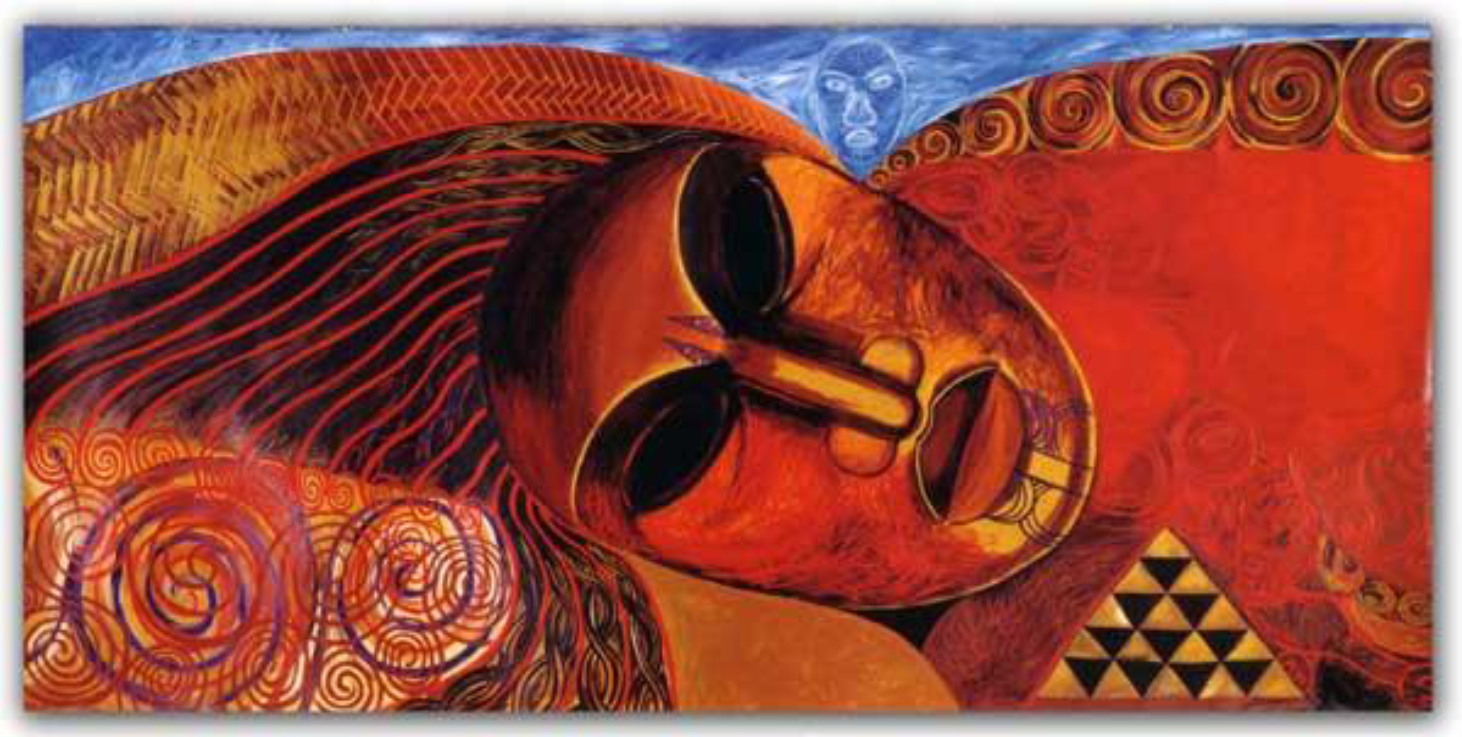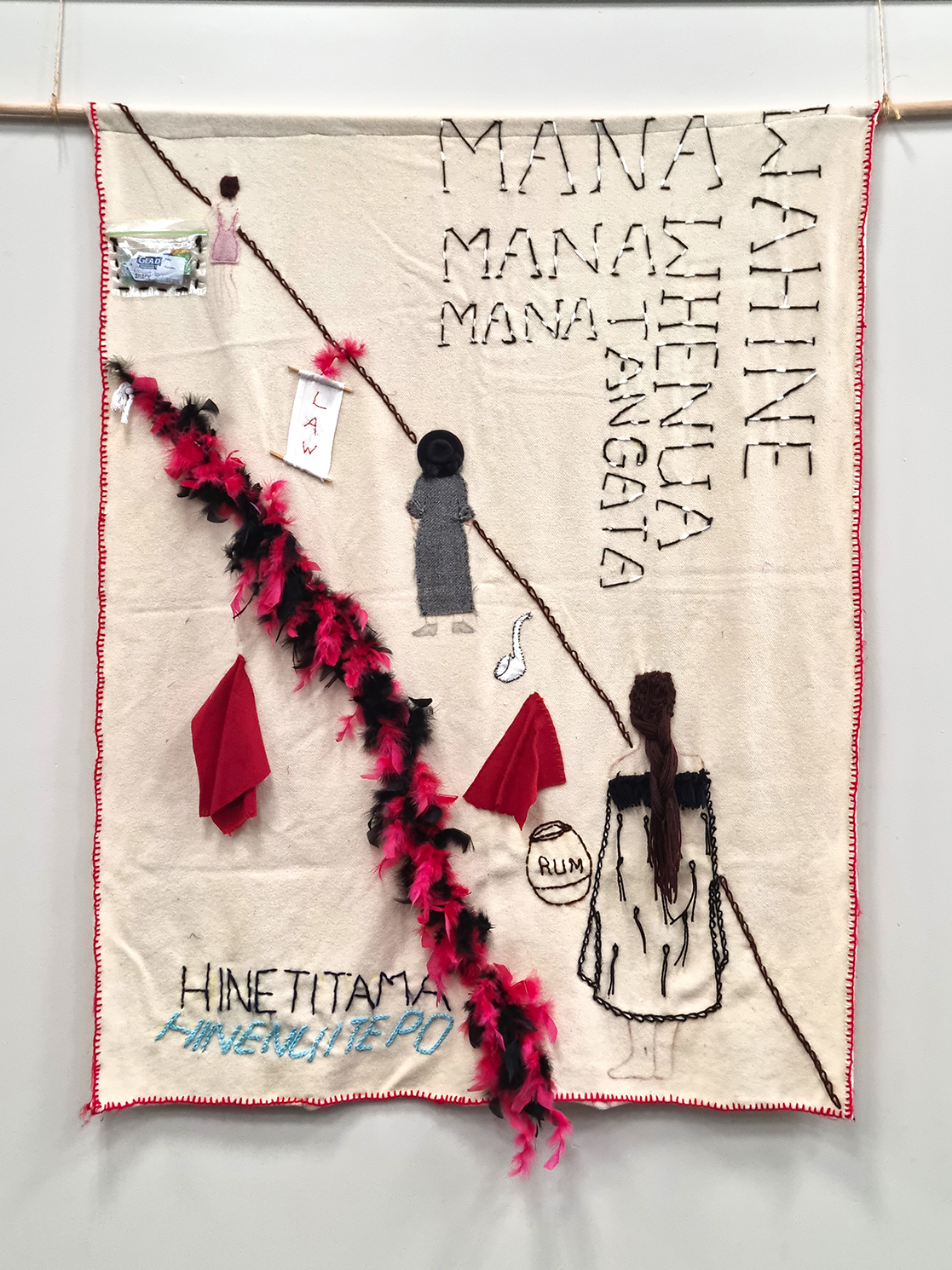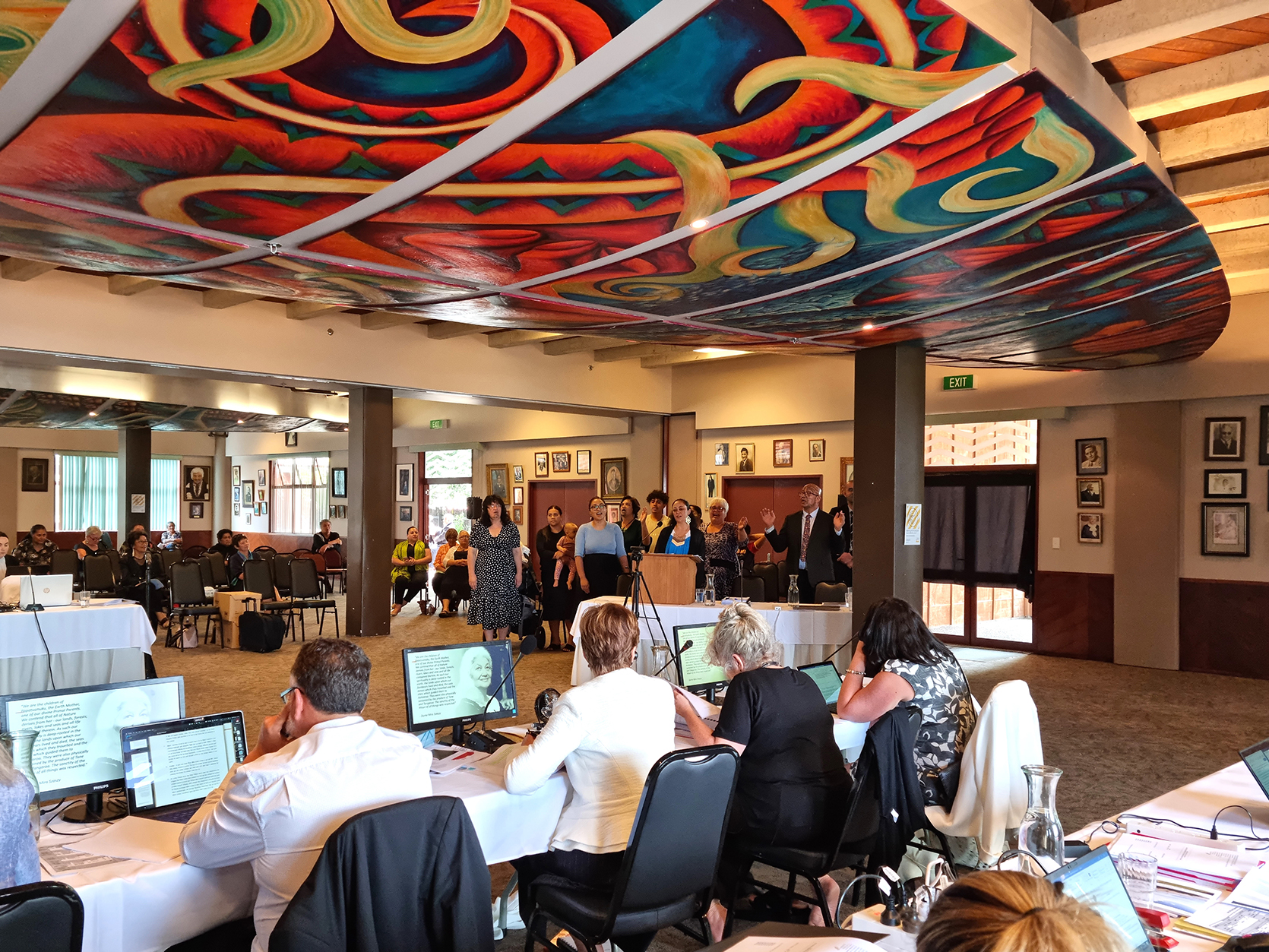What can we learn from traditional narratives about atua whāea?
He aha ngā akoranga ka puta ake i ngā kōrero tuku iho mō ngā atua whāea?
In the words of Paihere Clarke, ‘Our pūrākau inform us of our world past’ (doc A141, p 2(external link)). Atua narratives depict wāhine as key forces and drivers of many aspects of the world, such as the natural environment, the weather, time, and the afterlife. Witnesses said these narratives support the idea that wāhine also played significant roles in society before colonisation. Witnesses also said these narratives offer lessons for communities today about the power of wāhine.
Read more about lessons we can learn from atua narratives regarding:
Whakataukī
- Me aro koe ki te ha o Hineahuone / Pay heed to the dignity of women.
(Donna Awatere-Huata, doc A20, p 8(external link); Hinerangi Cooper-Puru, doc A27, p 4(external link), Hilda Halkyard-Harawira, doc A79, p 4(external link); Leonie Pihama, doc A19, p 5(external link)) - Ko Hineahuone koe, ko Hinetitama koe, ko Hinenuitepō anō hoki.
(Te Rua Wallace, doc A151, p 3(external link)) - He wāhine, Me Papa, e ora ai te tangata / Through women and Papa humankind continues.
(Ripeka Evans, doc A21, p 14(external link)) - He atua, he tangata / which Rangimarie Rose Pere explains as: ‘I am both Celestial and Terrestrial, we all are, and we resonate in a way that is appropriate for each one of us’.
(Leonie Pihama, doc A19, p 8(external link))
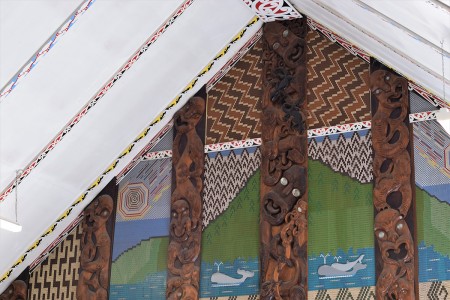
Interior of wharenui at Terenga Parāoa Marae, Whangārei
Lessons from atua narratives: about the role of wāhine in te ao Māori
What witnesses said
- “Our tūpuna conceived of the world as coming into existence via a sequence of generations, each born from the one preceding it. Te Kore is often described as a womb-like state, a space of limitless potential. Te Pō is born from the infinite realms of Te Kore. Rangi and Papa are conceived within Te Pō and themselves conceive many children, who are eventually born into Te Ao Mārama, the world of light. The progression from Te Kore, through to Te Pō and into Te Ao Mārama reveals that our tūpuna relied on the recurring cycle of conception, gestation and birth to help them explain the seemingly inexplicable.” (Ani Mikaere, doc A17, p 3)(external link)
- “The relation of the creation myth of the Sky Father Ranginui and the Earth Mother Papatūānuku and Hine-Ahu-One’s birth of the human race are proof that women did hold status and knowledge as well as power.” (Ripeka Evans, doc A21, pp 11-12)(external link)
- “The Māui legends give insight into the position of women as having the authority to make their own decisions (Taranga aborting her last child); possess magical powers and knowledge of formula and strategies (Māui’s grandmother Muri-ranga-whenua); possess knowledge of fire and energy for warmth and cooking (Māui‘s tupuna Mahuika), and finally to be overcome by the powers of the goddess of death Hine-Nui-te-Po.” (Ripeka Evans, doc A21, p 12)(external link)
- “Māori women in critical mythology occupy an important role. They assume the psychological dominance they achieve through the knowledge they have of the universe having power to control its force enter freely the spirit world and return to their earthly natures with few restrictions or demeanours. They have power to permit access to forbidden domains. They not only controlled the power, they also had control of the resources.” (Ripeka Evans, doc A21, p 11)(external link)
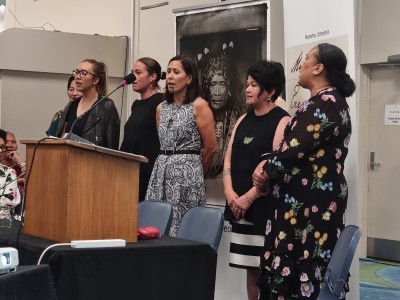
Rīpeka Evans with whānau at Turner Centre, Kerikeri
- “The Io teachings affirm the tapu of Papatuanuku and of the female element. We are fortunate to have the opportunity to share stories of my Ngātihau rangatira women who lived in the times when one’s history, boundaries, cultivations, wahi tapu, atua and karakia permeated their lives. The Io teachings were known by Patuone. Ordinary people were not schooled in Io because of the sacredness of Io’s being.” (Hana Maxwell, doc A69, p 9)(external link)
- “Throughout our mortal lives Papatūānuku is the source of our sustenance and survival. When we die Hinenuitepō caretakes our souls. Her supremacy is final and total. Women are the beginning and the end because of these atua. We are the only way in and out of this world through the sacred passage that is the birth canal. We open space through karanga because of Hineahuone and Papa and we close it through waiata because of Hinenuitepō. Whilst these tikanga continue, the understandings that underpin them and their central significance have been deliberately erased from the record. In times of transgression in pre-colonial times, wahine led muru plundering parties and at times, war parties to seek utu – the restoration of balance. This is one of the sacred role of wahine dictated by the atua wāhine and our cosmological stories. Maui transgressed sacred laws when he entered Hinenuitepō without invitation. She restored balance by annihilating him with her vulvic teeth – a symbol of the autonomous mana of wahine. The story is repeated a generation later with Hineteiwaiwa – the atua of women’s esoteric and ritual knowledge, and the tohunga Kae.” (Ngahuia Murphy, doc A67, p 5)(external link)
- “It is significant also that within the creation stories the first human form created is female, Hine-ahu-one. These stories … solidify the relationship between the maternal body and the land, and this is reaffirmed in the concept of te ūkaipō [the night feeding breast] as discussed earlier.” (Naomi Simmonds, doc A134, p 13)(external link)
- “The mana of atua wāhine and their importance in Māori society is clearly evidenced within the Māori astronomical record and its related practice. From an astronomical perspective atua wāhine held mana over the seasons, weather phenomena, crops, fresh water, rain, the afterlife, the promise of a new season, the tides and so much more. The entire Māori division of time was driven by atua wāhine, in particular the moon which drives the maramataka and the stars Matariki and Puanga that mark the beginning of the Māori year. Many female stars were connected to different flora and fauna and influenced all human life and day to day activities. Atua wāhine informed Māori when they should work, rest, plant, fish hunt, how bountiful the impending season would be and even when they should engage in sex in order to conceive. Atua wāhine were tapu, held mātauranga and mana over various domains and they were an example of how life should be conducted here on earth.” (Rangi Mātāmua, doc A86, p 12)(external link)
- “Hinetitama and her transcending as Hine-nui-te-po speaks truth to the traditional understanding and importance of wāhine in Te Ao Māori, we are a central figment to Māori existence in its entirety.” (Sandra Corbett, doc A45, p 3)(external link)
- “For every atua tāne, there is an atua wahine, they balance each other.” (Jessica Williams, doc A61, p 3)(external link)
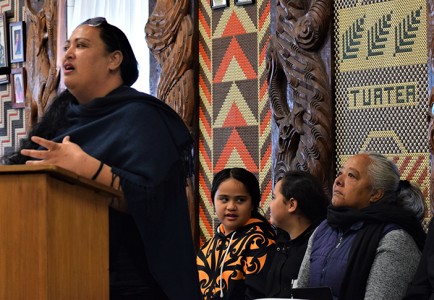
Jessica Williams giving evidence at Terenga Parāoa Marae, Whangārei, pictured with whānau (right)
- “Ka hoki ki a Hinetītama, ka huri rā ki a Hinenuitepō, ka kitea te kaha o te mana o te wāhine, me tana aroha i whakaaro nui ai mō āna tamariki me ngā whakatipuranga katoa ka huri ana ki tua o te ārai. Ki tā tēnei kuia rongonui a Rose Pere, tēnei kuia nō Tūhoe me Ngāti Ruapani, me Ngāti Kahunungu;
- Ko te tangata tuatahi he wahine. Ehara i hangaia e Tāne, e te Atua tāne rānei. Nā papatuānuku i hanga...e kī ana aku kaumātua, te take i hangaia he wahine te tangata tuatahi, ko te wahine ka whakawhānau i ngā tamariki katoa...Ko tātou katoa i ahu mai mai i te kōpū o te wahine.” (Dr Hiria Hape, doc A114, p 32)(external link)
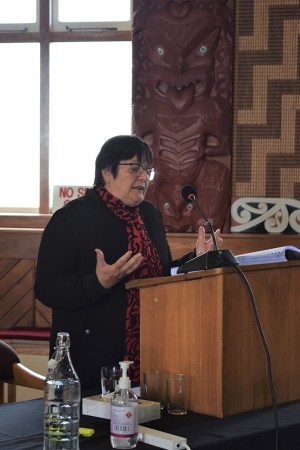
Dr Hiria Hape giving evidence at Waiwhetū Marae, Lower Hutt
Lessons from atua narratives: for life today
What witnesses said
- “When Hine tītama became aware that her husband was also her father she removed herself to the underworld. By doing so she taught us that it is not right for a father to have sexual intercourse with his own daughter … In her interaction with Maui, Hine nui te pō reminds us that life is not eternal, and that death cannot be avoided. Yet death need not be feared for although it is the end of life, it is the beginning of after life where wairua of those who have died may again be reunited.” (Patricia Tauroa, doc A60, p 5)(external link)
- “Perhaps the most important understandings from these whaea as I understand them, is that they show us a way to live; they teach understandings and respect and give comfort and solace, rather than portraying destruction and evil. We gain confidence because we know that our tūpuna lived by and through those ages with the same atua and their teachings. They believed that there was and is a spiritual element to life, a wairua, that protects us and is necessary for us to survive as human beings.” (Patricia Tauroa, doc A60, p 6)(external link)
- “If we see Papatuanuku as mother earth, the place on which we can stand and are nurtured so that we can grow, then the woman who becomes a mother is also the place where her children can find nurturing, sustenance, and the ability to grow. When a woman becomes a mother, she in essence becomes the living embodiment of Papatuanuku.” (Patricia Tauroa, doc A60, p 21)(external link)
- “What lessons can we learn from these stories? They are often stories of resilience, perseverance and endurance.” (Hinerangi Cooper-Puru, doc A27, p 5)(external link)
- “I have been taught that all mana is sourced from the atua and follows the whakapapa line through to the present day … The characteristics of our wāhine atua provide us with tools and understandings for how to live our lives today.” (Kayreen Tapuke, doc A94, pp 8-9)(external link)
- “Whaka – means to create, to cause, to bring about or to action. Papa – comes directly from Papatūānuku. Therefore, whakapapa is about establishing that solid foundation from whence we came as womankind originating from our earth mother. Whakapapa is the anchor and rock upon which we tether ourselves to in the storms of confusions and chaos that may come and momentarily disrupt us from our cultural identity.” (Te Ringahuia Hata, doc A30(b), p 6)(external link)
- “The ladies in these stories are all powerful and magical beings, all of which provide us with inspirational tales that empower women.” (Lee Harris, doc A23, pp 2-3)(external link)
- “Hine Titama, first light of the morning sun, she of breath-taking beauty. It is from her that we obtain the strength and courage of our convictions, she is the gamechanger, the shapeshifter. She who enacts self-determination. There are times when we need to stand in our own power and step into that place of courage to make the call that is needed and to do so without hesitation, to follow that unbidden surge of power that takes courage and conviction.” (Deirdre Nehua, doc A25, p 4)(external link)
- “The first woman is born out of Papatuanuku, so everything this physical body needs, Papatuanuku has provided through her son, and his / their creation “Te Waonui aTane”. That is why we need to be respectful and look after the environment. We need to be a lot better at tikanka.” (Ema Roriana Weepu, doc A136, p 7)(external link)
- “He mana kei roto i weneki kōrero, kei konei ngā akoranga hei whai atu mō mana wahine i wēneki tau, ā e hāere tonu mai nei. Anei pea he whakamārama, ka tāea te titiro whakamuri kātahi ka anga whakamua. Ehara i te mea me whakakore i tīmata, kua pou kē te tewhatewaha ki raro.” (Hera Black-Te Rangi and Mareta Taute, doc A116, p 14)(external link)
- “Ko Papatuanuku te wahine tuatahi o ngā wahine Atua. Whai muri iho ko Kurawaka, ko Hinetītama, kātahi ka rere ki te ao pōuriuri, Ko Hine nui te po. Taka rawa, ka mōhio ake ia ko tōnā tane, ko tōnā pāpa. He whakatūpato kei roto, he taharua tō te tangata, he wahine whai mana. Ahakoa he aha te whiu ki a ratou, ka taea.” (Hera Black-Te Rangi and Mareta Taute, doc A116, p 13)(external link)
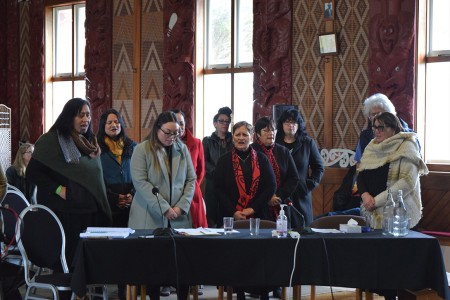
Hera Black (right) and whānau singing waiata at Waiwhetū Marae, Lower Hutt
